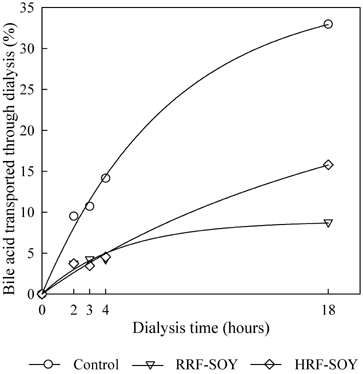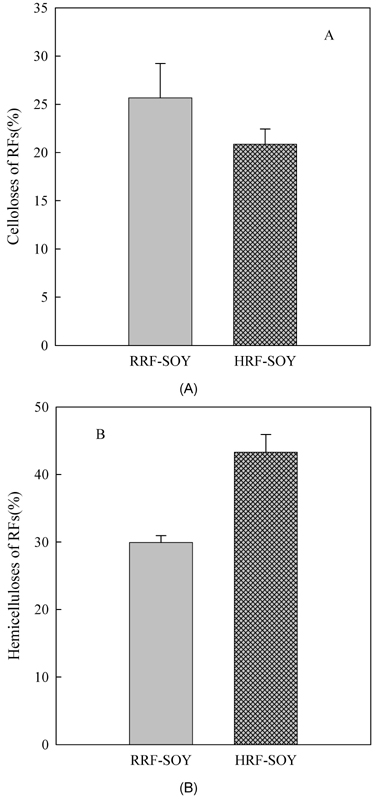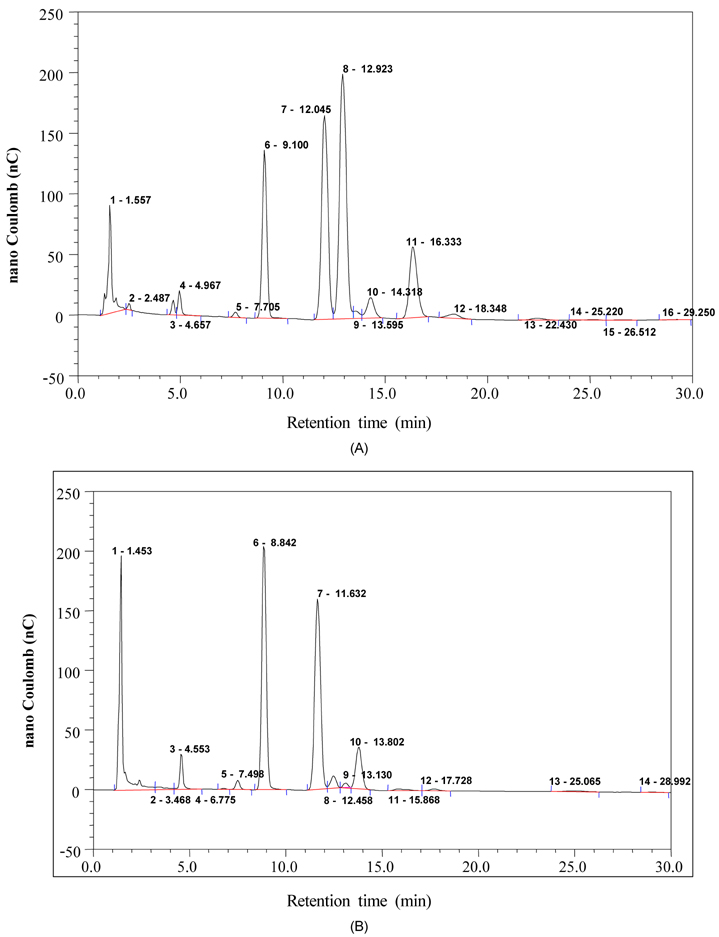Nutr Res Pract.
2009 Jun;3(2):149-155.
Effect of heat treatment of digestion-resistant fraction from soybean on retarding of bile acid transport in vitro
- Affiliations
-
- 1Institute of Life Science and Natural Resources, Korea University, 1 Anam-dong 5-ka, Sungbuk-gu, Seoul 136-701, Korea.
- 2Present post; Department of Applied Biological Chemistry, Graduate School of Agriculture, Kinki University, 3327-204 Naka-Machi, Nara, Nara 631-8505, Japan.
- 3Department of Food and Nutrition, Yuhan College, 185-34 Goean-dong, Sosa-gu, Bucheon, Kyeonggi 422-749, Korea.
- 4Division of Food Bioscience and Technology, College of Life Sciences and Biotechnology, Korea University, 1 Anam-dong 5-ka, Sungbuk-gu, Seoul 136-701, Korea. rhee2@korea.ac.kr
Abstract
- In this study, we investigated the heat effect of digestion-resistant fraction (RF) from soybean on retarding bile acid transport in vitro. The RFs from soybean retarded bile acid transport. A raw, unheated RF of soybean (RRF-SOY) was significantly more effective than the heated RF of soybean (HRF-SOY). The RS1 which physically trapped in milled grains and inaccessible to digestive enzyme after 18 hrs incubation level of content in RRF-SOY was found to be as high as 24.1% and after heating the RS1 of HRF-SOY was significantly reduced to 16.8%. The X-ray diffraction pattern of RF from soybean was altered after heat treatment. The RFs from soybean were characterized by peak at diffraction angles of 12.0degrees and 20.0degrees corresponding to RS content. Cellulose contents of RRF-SOY was 5% higher than that of HRF-SOY and pentosan contents of RRF-SOY was 5% higher than that of HRF-SOY, too. Whereas the hemicellulose content of RRF-SOY was 13% lower than HRF-SOY.
MeSH Terms
Figure
Reference
-
1. Albaum HG, Umbreit WW. Differntataion between ribose-3-phosphate and ribose-5-phosphate by means of the orcinol-pentose reaction. J Biol Chem. 1947. 167:369–376.
Article2. Anderson JW, Hanna TJ, Peng X, Kryscio RJ. Whole grain foods and heart disease risk. J Am Col Nutr. 2000. 19:291S–299S.
Article3. Annison G, Topping DL. Nutritional role of resistant starch: chemical structures vs physiological function. Annu Rev Nutr. 1994. 85:1461–1465.4. Delcour JA, Van Win H, Grobet PJ. Distribution and structual varitation of arabinoxylans in commn wheat mill streams. J Agric Food Chem. 1999. 47:271–275.
Article5. Dongowski G. Intractions between dietary fiber-rich preparations and glycoconjugated bile acids in vitro. Food Chem. 2007. 104:390–397.
Article6. Goni I, Garcia-Diz L, Manas E, Saura-Calixto F. Anaysis of resistant starch: a method for foods and food products. Food Chem. 1996. 56:445–449.7. Han KH, Sekikawa M, Shimada KI, Sasaki K, Ohba K, Fukushima M. Resistant starch fraction prepare from kintoki bean affects gene expression of gene associated with cholesterol metabolism in rat. Exp Biol Med. 2004. 229:787–792.
Article8. Han SH, Chung MJ, Lee SJ, Rhee Chul. Digestion-resistant fraction from soybean [Glycine max (L.) Merrill] induces hepatic LDL receptor and CYP7A1 expression in apolipoprotein E-deficient mice. J Nutr Biochem. 2006. 17:682–688.
Article9. Hashimoto S, Shogren MD, Pomeranz Y. Cereal pentosans : Their estimation and significance. I. Pentosan in wheat and milled wheat products. Cereal Chem. 1987. 64:30–34.10. He M, Hong J, Yang YX, Shen X. Influence of resistant starch on colon for a of mice. Wei Sheng Yan Jiu. 2005. 34:85–87.11. Higgins JA. Resistant starch : Metabolic effects and potential health benefits. J AOAC Int. 2004. 84:761–768.12. Ju IO, Jung GT, Ryu J, Kim YS. Effect of heat treatment on physical properties and in vitro glucose, bile acid, and cadmium transport retardation of wax ground (Benincase hispida). Korean J Food Sci Technol. 2003. 35:1117–1123.13. Kim DW, Yang JH, Jung YG. Hydrolysis of cellulose by enzyme mixture. Korean J of Chem Eng. 1986. 24:407–413.14. Lee CH, Oh SH, Yang EJ, Kim YS. Effects of raw, cooked, and germinated small black soybean powders on dietary content and gastrointestinal functions. Food Sci Biotechnol. 2006. 15:635–638.15. Lee KS, Kee SR. Retarding effect of dietary fibers on the glucose and bile acid movement across a dialysis membrane in vitro. Korean J Food Sci Technol. 1996. 29:738–746.16. Lee MY, Kim MK, Shin JG, Kim SD. Dietary effect of hemicellulose from soy fiber on blood glucose and cholesterol content in streptozotocin-induced diabetic rat. J Food Sci Nutr. 2004. 33:1119–1125.17. Lee SW, Lee JH, Han SH, Lee JW, Rhee C. Effects of various processing methods on the physical properties of cooked rice and on in vitro hydrolysis and blood glucose response in rat. Starch/Stärke. 2005. 57:531–539.
Article18. Lee YT, Yoo JW, Yoo MS, Choi KH, Kim JH, Seog HM. Retarding effects of β-glucan separated from barley bran on in vitro transport. Food Sci Biotechnol. 2003. 12:298–302.19. Leeuw JA, Tongbloed AW, Verstegen MWA. Dietary fiber stabilizes blood glucose and insulin levels and reduces physical activity in sow (Susscrofa). J Nutr. 2004. 134:1481–1486.20. Leu RKL, Hu LY, Young GP. Effects of resistant starch and nonstarch polysaccarides on colonic luminal enviroment and genotoxin-induced apoptosis in the rat. Carcinogenesis. 2002. 23:713–719.21. Marlett JA, Fischer MH. Session : Physiological aspects of fiber. The active fraction of psyllium seed husk. Proc Nutr Soc. 2003. 62:207–209.22. Mccleary BV, Monaghan DA. Measurement of resistant starch. J AOAC Int. 2002. 85:665–675.
Article23. Nagata JI, Higashiuesato Y, Maeda G, Chnen I, Saito M, Iwabuchi K, Onoe K. Effects of water-soluble hemicellulose from soybean hull on serum antibody levels and activation of microphages in rats. J Agric Food Chem. 2001. 49:4965–4970.
Article24. Park JY, Yang MZ, Jun HS, Lee JH, Bae HK, Park TS. Effect of raw brown rice and Job's Tear supplemented diet on serum and hepatic lipid concentrations, antioxidative system, and immune function of rat. J Food Sci Nutr. 2003. 32:197–206.25. Periago MJ, Ros G, Casas JL. Non-Starch Polysaccharides and in Vitro Starch Digestibility of Raw and Cooked Chick Peas. J Food Sci. 1997. 62:93–96.
Article26. Ruan D, Zhang L, Zhou J, Jin H, Chen H. Structure and properties of novel fibers spun from cellulose in NaOH/Thioura aqueous solution. Macromol Biosci. 2004. 4:1105–1112.
Article27. Sajilata MG, Singhal RS, Kulkarni PR. Resistant starch-a review. Comprehensive reviews in food science and food safety. Institute of Food Technologists. 2006. 5:1–17.28. Seo EJ, Yoo SH, Oh KW, Cha JH, Lee HG, Park CS. Isolation of an exopolycasaccharide-producing bacterium Shingomonas sp. CS101, which forms an unusal type of shingan. Biosci Biotechnol Biochem. 2004. 68:1146–1148.
Article29. Sievert D, Czuchajowska Z, Pomeranz Y. Enzyme-resistant starch. III. X-ray diffraction of autoclaved amylomaize VII starch and enzyme-resistant starch residues. Cereal Chem. 1991. 68:86–91.30. Takahashi T, Karita S, Ogawa N, Goto M. Crystalline cellose reduces plasma glucose concentrations and stimulates water absorption by increasing the digesta viscosity in rats. J Nutr. 2005. 135:2405–2410.
Article31. Vazquez MJ, Alonso JL, Dominguez H, Parajo JC. Xylooligosaccharides : manufacture and applications. Trends in Food Science & Technology. 2000. 11:387–393.32. Xie X, Liu Q, Cui SW. Studies on the granular structure of resistant starchs (type 4) from normal, high amylose and waxy corn starch citrates. Food Res Intern. 2006. 39:332–341.
Article
- Full Text Links
- Actions
-
Cited
- CITED
-
- Close
- Share
- Similar articles
-
- Proteomic Analysis of Intracellular and Membrane Proteins From Voriconazole-Resistant
Candida glabrata - Bile Acid Receptors in Cholangiocyte
- Bile Acid Transporters Are Expressed and Heterogeneously Distributed in Rat Bile Ducts
- Bile Acids and the Metabolic Disorders
- Role of Sodium Ion in Renal Transport of p-Aminohippurate in vitro
- Proteomic Analysis of Intracellular and Membrane Proteins From Voriconazole-Resistant






